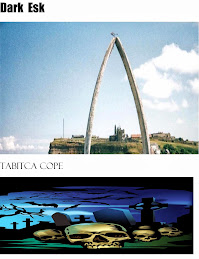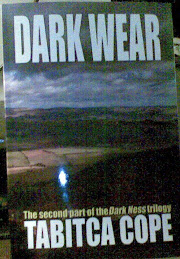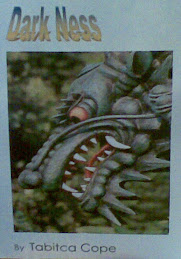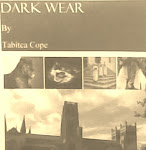On a warm summer night in 1997, local Bigfoot researcher and part-time gold-mining enthusiast William Allen Barnes was plunged headlong into the world of cryptozoology. (Barnes dislikes using the term Bigfoot due to its exploitation by those who have tried to capitalize on, or trivialize the phenomenon, preferring to use the term North American ape/hominoid.)Barnes was camping alone near Greenhorn Creek, southeast of Grass Valley. He was asleep in a small pup tent with the rain flap up when a loud noise woke him sometime after midnight.“About 1 or 2, I heard this thing coming down the canyon and I could hear it walking around,” Barnes said. “I figured it was a bear.”As he listened and tried to catch a glimpse of what was approaching, he began to realize that it might be something completely unfamiliar to him.“I could see this dark blob and when it got about thirty feet from my car, I noticed how tall it looked above the hood,” he said. “I thought, ‘Oh my gosh, it can't be a bear.' It got to the car, then headed straight toward my tent.” What happened next is something that Barnes says has haunted him ever since, and fueled his desire to prove the existence of a giant creature most consider well outside the realm of possibility.“It was looking down on me through the flap in the tent and I had no place to go, no gun and no flashlight,” Barnes said. “My heart was beating so loudly, I could hear it pounding in my ears. When it turned sideways, I saw how thick it was and I realized it had no neck and didn't seem to have a nose. It looked ape-like.”
Eventually, the creature — which Barnes guessed to weigh somewhere between 450 and 500 pounds — seemed to lose interest, turning to walk up a nearby hill and disappearing into the darkness. “After it left, the adrenaline hit me and I just sat there and shook,” Barnes said. “I got up the next morning and left. It took me four years to go back out there into the canyon by myself, and my gun got bigger every year.”Since that time, Barnes has driven himself to find out as much as he can about the creature he encountered, while thinking of possible ways that he could prove its existence.In the last decade, he has joined forces with several other researchers, namely Jason Valenti (SasquatchResearch.net) and William Dranginis (VirginiaBigfootResearch.org), to initiate the Falcon Project to capture motion picture evidence of a hominoid.The plan is to travel to hominoid hot spots in the U.S. and Canada where multiple sightings have been reported, and to nightly launch a remote-controlled blimp, using thermal imaging, carbon dioxide recognition and high-tech audio equipment to track what is below.The camera on board will be so powerful that it can zoom in on objects with almost microscopic detail from as high as 2,000 feet and will be able to film from any angle, Barnes said.“The airship is actually two helium-filled blimps held together by graphite and will float in the same way a catamaran does,” Barnes said. “We'll be searching in Northern California, Oregon, Washington, British Columbia, Texas, Mississippi, Arkansas, Virginia, Eastern Tennessee around the Smoky Mountains and Florida.”Barnes estimates the trip could last as long as a year and will cost in the neighborhood of $190,000.The airship is to be manufactured by a Canadian company and the equipment used to operate and monitor the Falcon will be housed inside an RV that Barnes and his cohorts will travel in.The group is still in the process of raising the necessary funds, but Barnes believes the wait will not be much longer.It would be easy for the casual reader to dismiss the Falcon project, its founder and the creature it seeks to uncover, but remember the coelacanth, a fish thought to be extinct for at least 65 million years, found alive when a specimen was caught in South Africa in 1938. There have been other documented sightings since then, including discovery of a second species of coelacanths found in Indonesia in 1999. And think too of explorers like German businessman Heinrich Schliemann, who in 1868 discovered the ancient city of Troy, while the rest of the archaeological world was convinced it was only a legend.When discussing hominoids with Barnes, it's difficult not to be struck by his earnestness and the missionary-like zeal with which he approaches his subject. He very much appears a true believer propelled by “scientific revelation.”
“We want to film a hominoid over a long period of time, so that scientists can then study its movements,” Barnes said. “I'm not trying to prove something that others don't already know. I'm just trying to film it in its natural habitat.”For more information about Barnes and the Falcon Project, go to www.Bigfoot24-7.com.
Eventually, the creature — which Barnes guessed to weigh somewhere between 450 and 500 pounds — seemed to lose interest, turning to walk up a nearby hill and disappearing into the darkness. “After it left, the adrenaline hit me and I just sat there and shook,” Barnes said. “I got up the next morning and left. It took me four years to go back out there into the canyon by myself, and my gun got bigger every year.”Since that time, Barnes has driven himself to find out as much as he can about the creature he encountered, while thinking of possible ways that he could prove its existence.In the last decade, he has joined forces with several other researchers, namely Jason Valenti (SasquatchResearch.net) and William Dranginis (VirginiaBigfootResearch.org), to initiate the Falcon Project to capture motion picture evidence of a hominoid.The plan is to travel to hominoid hot spots in the U.S. and Canada where multiple sightings have been reported, and to nightly launch a remote-controlled blimp, using thermal imaging, carbon dioxide recognition and high-tech audio equipment to track what is below.The camera on board will be so powerful that it can zoom in on objects with almost microscopic detail from as high as 2,000 feet and will be able to film from any angle, Barnes said.“The airship is actually two helium-filled blimps held together by graphite and will float in the same way a catamaran does,” Barnes said. “We'll be searching in Northern California, Oregon, Washington, British Columbia, Texas, Mississippi, Arkansas, Virginia, Eastern Tennessee around the Smoky Mountains and Florida.”Barnes estimates the trip could last as long as a year and will cost in the neighborhood of $190,000.The airship is to be manufactured by a Canadian company and the equipment used to operate and monitor the Falcon will be housed inside an RV that Barnes and his cohorts will travel in.The group is still in the process of raising the necessary funds, but Barnes believes the wait will not be much longer.It would be easy for the casual reader to dismiss the Falcon project, its founder and the creature it seeks to uncover, but remember the coelacanth, a fish thought to be extinct for at least 65 million years, found alive when a specimen was caught in South Africa in 1938. There have been other documented sightings since then, including discovery of a second species of coelacanths found in Indonesia in 1999. And think too of explorers like German businessman Heinrich Schliemann, who in 1868 discovered the ancient city of Troy, while the rest of the archaeological world was convinced it was only a legend.When discussing hominoids with Barnes, it's difficult not to be struck by his earnestness and the missionary-like zeal with which he approaches his subject. He very much appears a true believer propelled by “scientific revelation.”
“We want to film a hominoid over a long period of time, so that scientists can then study its movements,” Barnes said. “I'm not trying to prove something that others don't already know. I'm just trying to film it in its natural habitat.”For more information about Barnes and the Falcon Project, go to www.Bigfoot24-7.com.
Tom Kellar is a freelance writer living in Cedar Ridge.
Source:http://www.theunion.com/article/20100905/NEWS/100909870/1001&parentprofile=1053
Sasquatch Odyssey: The Hunt for Bigfoot
Bigfoot Casebook updated: Sightings And Encounters from 1818 to 2004
Source:http://www.theunion.com/article/20100905/NEWS/100909870/1001&parentprofile=1053
Sasquatch Odyssey: The Hunt for Bigfoot
Bigfoot Casebook updated: Sightings And Encounters from 1818 to 2004





















No comments:
Post a Comment